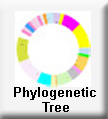Genus Mesocriconema
Andrássy, 1965
|
Syn.:
|
Madinema Khan, Chawla & Saha, 1976
Seshadriella Darekar & Khan, 1981
Crossonemoides Eroshenko, 1981
Neobakernema Ebsary, 1981
Pakcriconemoides Shahina & Maqbool, 1993 |
Diagnosis
Criconematidae
Females. Plump nematodes, 0.3-0.6 mm
long (exceptionally longer). Cuticle with retrorse annuli, margins
smooth, uneven or crenated, no posterior appendages. First annulus
seldom separated, second annulus usually wider than the first. Submedian
lobes as outgrowths of much reduced pseudolips, exceptionally absent.
Labial plates present or absent. Vulva open, anterior vulval lip
ornamented in a few species. Postvulval body part usually short,
terminus round or truncate, seldom acute.
Males. Anterior end rounded.
Lateral field with four grooves (lines). Bursa usually well developed
and enclosing terminus, rarely narrow and shorter. Terminus round
to acute.
Juveniles. With smooth, uneven or crenate
posterior margins of annuli, never with appendages and annules in profile
never drawn out posteriad.
Remarks
The above diagnosis characterises the genus mainly by the submedian
lobes and open vulva. However, a few species apparently do not have
submedian lobes, but we considered this lack as secondarily absent or lost,
as understood by Lorenzen (1996).
The genus Mesocriconema is most closely related
to the genera Criconemoides and Xenocriconemella Loof &
De Grisse, 1965, and can be differentiated by the following characteristics
illustrated with scanning electron microscope (SEM) micrographs by Loof
and De Grisse (1989).
From Criconemoides, it differs by having
an open vulva and submedian lobes arising from reduced pseudolips (in Criconemoides
vulva is closed, pseudolips not reduced, forming submedian lobes themselves).
From Xenocriconemella, it differs by structure
of vulva and anterior body end (in Xenocriconemella the vulva is
closed and vulval lips form a 'sleeve', the first annulus lies not anterior
to the second, but inside it).
Pakcriconemoides was proposed with the type
species P. anastomoides (Maqbool & Shahina, 1985) and P.
microdorus (De Grisse, 1964a) was included as another species.
The type species was transferred to Mesocriconema by Loof and De
Grisse (1989). The main diagnostic differences between Mesocriconema
and Pakcriconemoides are the open vulva and anchor-shaped stylet
knobs in the former, vulva closed and shorter stylet with rounded knobs
in the latter. However, the light microscope photograph of the type
species suggests an open vulva, while SEM micrographs of the head end show
true submedian lobes. The second species included, P. microdorus,
has an open vulva. These characters are essential for the genus Mesocriconema
as outlined by Loof and De Grisse (1989) and in the diagnosis above and
therefore we, like Siddiqi (2000), synonymise both genera. The differences
in the stylet length and shape of knobs are considered to be of specific
and not of generic importance.
Type species
Mesocriconema pruni (Siddiqi, 1961) Andrássy,
1965
subjective
synonym of M. xenoplax (Raski, 1952) Loof & De Grisse, 1989.
(Description- M. W. Brzeski et al., 2002)
This
genus included in the Criconematid Project
DNA Sequences Obtained
| Specimen: |
collected: |
| 16547 |
La Selva Station, Peccary Ex-plots, Costa Rica |
| 16546 |
La Selva Station, Peccary Ex-plots, Costa Rica |
| 16544 |
Costa Rica |
| N183090 |
Costa Rica, pineapple |
| N184034 |
Costa Rica, palm |
| N184035 |
Costa Rica, palm |
| 16138 |
La Selva Station, Cosa Rica |
| 14268 |
La Selva Station, Costa Rica |
| N223083 |
9-Mile Prairie, NE |
| 13454 |
9-Mile Prairie, NE |
| 16565 |
Reichelt Prairie, IA |
| 16801 |
Williams Prairie, IA |
Species
List (from Ebsary, 1991)
Species found
at:



